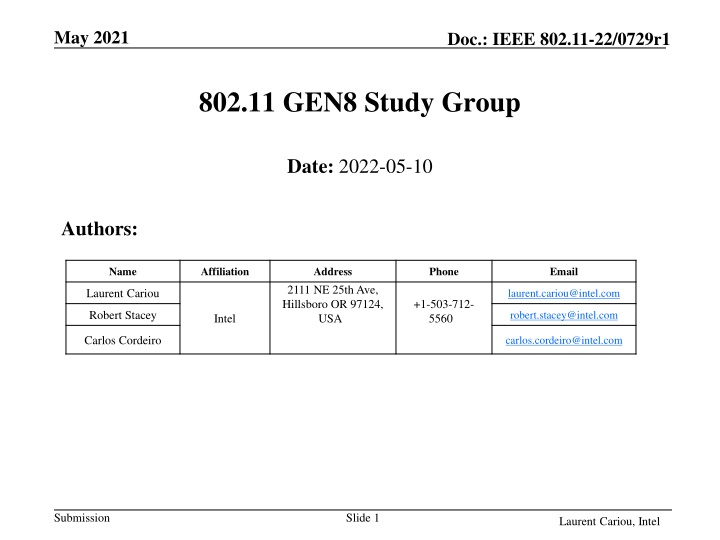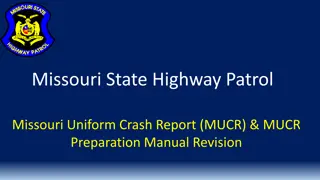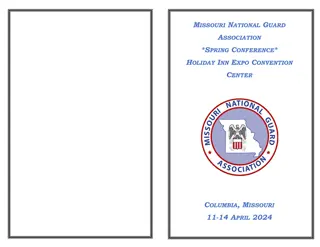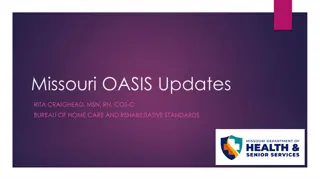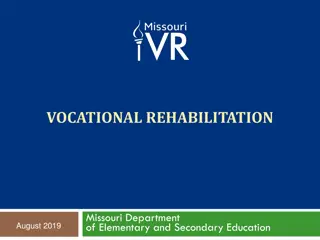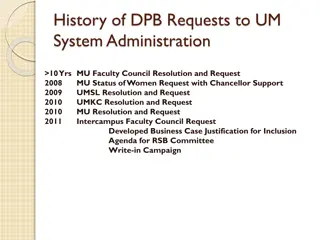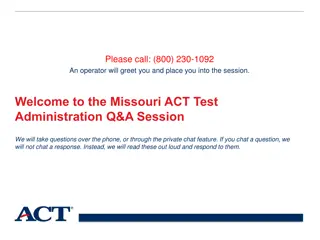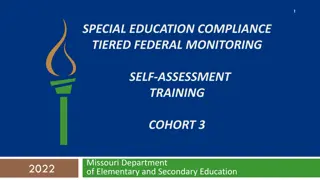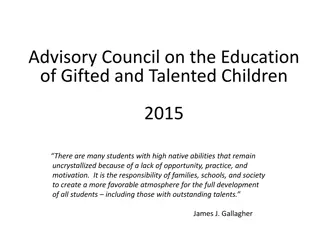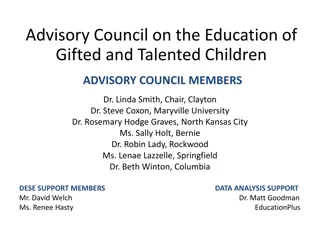Missouri's BRITE Act: A Review of Successful Collaboration
This session delves into the collaborative efforts behind Missouri's BRITE Act, ensuring students with visual impairments receive comprehensive education. Explore key components, outcomes, and the impact on Braille literacy.
Download Presentation

Please find below an Image/Link to download the presentation.
The content on the website is provided AS IS for your information and personal use only. It may not be sold, licensed, or shared on other websites without obtaining consent from the author.If you encounter any issues during the download, it is possible that the publisher has removed the file from their server.
You are allowed to download the files provided on this website for personal or commercial use, subject to the condition that they are used lawfully. All files are the property of their respective owners.
The content on the website is provided AS IS for your information and personal use only. It may not be sold, licensed, or shared on other websites without obtaining consent from the author.
E N D
Presentation Transcript
May 2021 Doc.: IEEE 802.11-22/0729r1 802.11 GEN8 Study Group Date: 2022-05-10 Authors: Name Affiliation Address Phone Email 2111 NE 25th Ave, Hillsboro OR 97124, USA Laurent Cariou laurent.cariou@intel.com +1-503-712- 5560 Robert Stacey robert.stacey@intel.com Intel Carlos Cordeiro carlos.cordeiro@intel.com Submission Slide 1 Laurent Cariou, Intel
May 2021 Doc.: IEEE 802.11-22/0729r1 GEN8 Study Group Key drivers XR applications Demand for higher throughput Combined with low and predictable/deterministic latency More P2P links More devices Laptops/tablets/phones/watches Gaming consoles/Displays/Cameras/Personal assistants, Etc. Usage everywhere (densification issue) Submission Slide 2 Laurent Cariou, Intel
May 2021 Doc.: IEEE 802.11-22/0729r1 GEN8 Study Group: key objectives Where should Wi-Fi be in 2028, six years from now? Real-life and practical improvements in terms of: Per-device and system-wide throughput Deterministic/worst-case latency and further reduce latency Improve throughput/deterministic latency in dense environments Achieve consistent experience whether in a dense or sparse environment Submission Slide 3 Laurent Cariou, Intel
May 2021 Doc.: IEEE 802.11-22/0729r1 GEN8 Study Group main candidate lighthouse features Multi-AP set of features in sub-7 GHz different flavors of cooperation between APs. (C-TDMA, C-OFDMA, C-SR, C-BF, MU-MIMO JP). Targets multiple objectives: throughput, latency, range, area throughput, reliability, Coordination with P2P New spectrum Only meaningful way to improve throughput/latency is to reduce congestion MLO framework makes it easy to add new bands Some Low latency/QoS features Note: Other features (A-PPDU, ) not raising to the level of a lighthouse feature Note: Increasing BW in 5/6 GHz will not deliver real-life gains dense deployments require high frequency reuse, 320 MHz already not usable in enterprise deployments because of not enough frequency reuse - 21/1536-some-observations-on-optimizing- 802-11be-release-1-with-respect-to-enterprise-ap-use-cases.pptx Submission Slide 4 Laurent Cariou, Intel
May 2021 Doc.: IEEE 802.11-22/0729r1 Some applications throughput/latency requirements 3GPP TS 22.261 v18.5.0 Table 7.6.1-1 KPI Table for additional high data rate and low latency service Characteristic parameter (KPI) Influence quantity Use Cases Max allowed end-to-end latency Service bit rate: user-experienced data rate 0,1 to [1] Gbit/s supporting visual content (e.g. VR based or high definition video) with 4K, 8K resolution and up to120 frames per second content. 0,1 to [1] Gbit/s supporting visual content (e.g. VR based or high definition video) with 4K, 8K resolution and up to120 frames per second content. # of UEs Service Area (note 2) Reliability UE Speed 5 ms (i.e. UL+DL between UE and the interface to data network) (note 4) 99,99 % in uplink and 99,9 % in downlink (note 4) Cloud/Edge/Split Rendering (note 1) Stationary or Pedestrian - Countrywide 20 m x 10 m; in one vehicle (up to 120 km/h) and in one train (up to 500 km/h) Gaming or Interactive Data Exchanging (note 3) 99,99 % (note 4) Stationary or Pedestrian 10ms (note 4) [10] Consumption of VR content via tethered VR headset (note 6) [5 to 10] ms (note 5) 0,1 to [10] Gbit/s (note 5) Stationary or Pedestrian [99,99 %] - - NOTE 1: Unless otherwise specified, all communication via wireless link is between UEs and network node (UE to network node and/or network node to UE) rather than direct wireless links (UE to UE). NOTE 2: Length x width (x height). NOTE 3: Communication includes direct wireless links (UE to UE). NOTE 4: Latency and reliability KPIs can vary based on specific use case/architecture, e.g. for cloud/edge/split rendering, and may be represented by a range of values. NOTE 5: The decoding capability in the VR headset and the encoding/decoding complexity/time of the stream will set the required bit rate and latency over the direct wireless link between the tethered VR headset and its connected UE, bit rate from 100 Mbit/s to [10] Gbit/s and latency from 5 ms to 10 ms. NOTE 6: The performance requirement is valid for the direct wireless link between the tethered VR headset and its connected UE. Submission Laurent Cariou, Intel
May 2021 Doc.: IEEE 802.11-22/0729r1 Example of enterprise scenario capturing some key challenges One among many representative dense scenarios (e-learning, auditorium, hospital ) 2 m Cubicle scenario 16 cubes within a 10m square XR P2P links in some cubes: LOS, around 1m range Requirements: DL up to 10Gbps (average 1Gbps), UL low throughput but 2ms latency Infrastructure APs to serve fixed or mobile users in the area STA1 STA4 2 m STA2 XR HDM STA3 Deployment in 5/6GHz: Spectrum needs to be shared between infrastructure APs and all P2P links that are in the same area Interference between XR P2P links Interference with infrastructure BSSs Even with full 6 GHz band: not enough capacity Submission Slide 6 Laurent Cariou, Intel
May 2021 Doc.: IEEE 802.11-22/0729r1 Lessons learned on most effective types of features Analysis shows clearly that big leap forward on real life performance are generated by new bands and larger bandwidths with sufficient freq reuse 802.11ax as a good example trying to solve the densification issue Multi-user operation (OFDMA) brought densification benefits, but did not bring significant throughput gains in the end in most of the scenarios 6 GHz operation generates many user experience gains enabler for larger BW (160MHz) even in enterprise More channels, less contention -> better throughput, better latency, However, not enough 320MHz channels available to be used on enterprise deployments (need reuse 8-9) This is even more true now as we are getting closer to the spectrum efficiency enhancement limits and every application requires more throughput and bandwidth as we highlighted in previous presentation (22/0046r1) We reached a point where it becomes very hard to increase capacity/density by adding more antennas, wider channels, higher order modulation.. Submission Slide 7 Laurent Cariou, Intel
May 2021 Doc.: IEEE 802.11-22/0729r1 Challenges for GEN8 SG/TG Benefits from Multi-AP features will likely resemble Multi-user benefits seen with MU features in 11ax Limited gains for the reasonable M-AP features Latency/throughput in 2.4/5/6 GHz will be limited by channel load M-AP and other coordination tools mostly try and preserve efficiency until a slightly higher load Limitations will be seen very quickly on representative scenarios Most efficient tool will be to get more spectrum to get more 160 MHz channels or to enable deployments of 320 MHz channels Again, 320MHz won t be usable in real life enterprise deployments because of only 3 channels available. If we manage to get more channels, that becomes possible Submission Slide 8 Laurent Cariou, Intel
May 2021 Doc.: IEEE 802.11-22/0729r1 Demand for new spectrum Mainstream Wi-Fi has expanded into new spectrum over generations: 2.4 GHz band: Through 2007 meets most consumer needs. Almost all devices are single band. 5 GHz band: Starting with 11n deployments and rapidly accelerating with 11ac deployments, consumers increasing turn to 5 GHz band to reduce congestion. By 2021 [probably earlier] nearly 100% of device are dual-band. 6 GHz band: With 11ax deployments there is increasing use of the 6 GHz band. This ramp is much faster than we saw with 11n/11ac. By 2028 we expect all devices to be tri-band. We expect that around 2028 there will be significant demand for new spectrum, driven by: The increasing demand for increased throughput and reduced latency from new applications The increasing number of devices using the spectrum The limited availability of 160/320 MHz channels and the need to share this spectrum In some regions this demand will hit sooner, for example: Some regions don t have access to the upper 6 GHz band (e.g., EU) Other regions don t have access to 6 GHz band at all (e.g., China) Submission Slide 9 Laurent Cariou, Intel
May 2021 Doc.: IEEE 802.11-22/0729r1 Spectrum for 802.11 GEN8 While we can make some tweaks to 802.11 to increase throughout and slightly reduce latency, we believe the only real, future-proof solution is to increase capacity We believe a primary goal of the study group should be to identify the additional bands (beyond 2.4/5/6 GHz) for mainstream Wi-Fi circa 2028 To us, the 60 GHz unlicensed band looks compelling Up to 14 GHz of available unlicensed spectrum and worldwide allocations Even in dense environments links are isolated from each other Competitive with 3GPP Goal to reuse the 2.4/5/6 GHz design in 60 GHz to keep complexity within the bounds of lower band 802.11 Investigate opportunities for additional unlicensed or lightly licensed spectrum in this timeframe Submission Slide 10 Laurent Cariou, Intel
May 2021 Doc.: IEEE 802.11-22/0729r1 Conclusion Form study group at the July session Suggest calling it the GEN8 SG Aligns with broader Wi-Fi market generational naming Does not emphasize one performance metric over another Propose the scope to be focused on improving throughput and deterministic/worst-case latency especially in dense environments A primary goal of the study group should be identifying bands beyond 2.4/5/6 GHz that we target for mainstream Wi-Fi circa 2028 Submission Slide 11 Laurent Cariou, Intel
